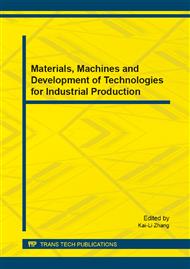[1]
N. Asim, S. Radiman, M. A. Yarmo, Synthesis of WO3 in Nanoscale with the Usage of Sucrose Ester Microemulsion and CTAB Micelle Solution Materials Letters. 61(2007) 2652–2657.
DOI: 10.1016/j.matlet.2006.10.014
Google Scholar
[2]
A. G. MacDiarmid, Polyaniline and polypyrrole: Where are we headed? Synthetic Metals. 84(1997) 27-34.
DOI: 10.1016/s0379-6779(97)80658-3
Google Scholar
[3]
S. Bhadra, N. K. Singha, D. Khastgir, Electrochemical Synthesis of Polyaniline and its Comparison with Chemically Synthesized Polyaniline. Journal of Applied Polymer Science. 104(2007) 1900 - (1904).
DOI: 10.1002/app.25867
Google Scholar
[4]
A. T. Ozyilmaz, T. Tuken, B. Yazici, M. Erbil, The Electrochemical Synthesis and Corrosion Performance of Polyaniline on Copper. Progress in Organic Coating. 52(2005) 92-97.
DOI: 10.1016/j.porgcoat.2004.09.003
Google Scholar
[5]
T. Tuken, A. T. Ozyilmaz, B. Yazici, M. Erbil, Electrochemical Synthesis of Polyaniline on Mild Steel in Acetonitrile-LiClO4 and Corrosion Performance. Applied Surface Science. 236(2004) 292-305.
DOI: 10.1016/j.apsusc.2004.05.001
Google Scholar
[6]
Shirakawa, H. The Discovery of Polyacetylene Film: the Dawning of an Era of Conducting Polymers. Synthetic Metals. 125(2001) 3-10.
Google Scholar
[7]
A. G. MacDiarmid, Synthetic Metals: A Novel Role for Organic Polymers. Synthetic Metals. 125(2001) 11–22.
DOI: 10.1016/s0379-6779(01)00508-2
Google Scholar
[8]
T. J. Mason, J. Lorimer, Quantifying Sonochemistryly: Casting Some Light on a Black Art,. Ultrasonic. 30(1992) 40-42.
DOI: 10.1016/0041-624x(92)90030-p
Google Scholar
[9]
Price, G. J.; Norris, G. J.; Peter, J. Polymerization of Methyl Methacrylate Initiated by Ultrasound. Macromolecules. 25(1992); 6447-6454.
DOI: 10.1021/ma00050a010
Google Scholar
[10]
H. M. Cheung, K. Gaddam, Ultrasound-Assisted Emulsion Polymerization of Methyl Methacrylate and Styrene. Journal of Applied Polymer Science. 76(2000) 101-104.
DOI: 10.1002/(sici)1097-4628(20000404)76:1<101::aid-app13>3.0.co;2-f
Google Scholar
[11]
S. Wizel, S. Margel, A. Gedanken, The Preparation of a Polystyrene–Iron Composite by using Ultrasound Radiation. Polymer International. 49(2000) 445-448.
DOI: 10.1002/(sici)1097-0126(200005)49:5<445::aid-pi294>3.0.co;2-9
Google Scholar
[12]
R. V. Kumar, Y. Koltypin, Y. S. Cohen, Y. Cohen, D. Aurbach, O. Palchik, I. Felner, A. Gedanken, Preparation of Amorphous Magnetite Nanoparticles embedded in Polyvinyl Alcohol using Ultrasound Radiation. Journal of Materials Chemistry. 10(2000).
DOI: 10.1039/b000440p
Google Scholar
[13]
R. V. Eldik, C. D. Hubbard, Chemistry under Extreme or Non-Classical Conditions. Journal of Chemical Education. 74(1997) 764.
Google Scholar
[14]
H. Xia, Q. Wang, Ultrasonic Irradiation: A Novel Approach to Prepare Conductive Polyaniline/Nanocrystalline Titanium Oxide Composites. Chemistry of Material. 14(2002) 2158-2165.
DOI: 10.1021/cm0109591
Google Scholar
[15]
Y. Li, F. Qian, J. Xiang, C. M. Lieber, Nanowire Electronic and Optoelectronic Devices. Materials Today. 9(2006) 18–27.
DOI: 10.1016/s1369-7021(06)71650-9
Google Scholar
[16]
J. Laska, J. Widlarz, Spectroscopic and structural characterization of low molecular weight fractions of polyaniline. Polymer. 46(2005) 1485–1495.
DOI: 10.1016/j.polymer.2004.12.008
Google Scholar
[17]
J. Stejskal, I. Sapurina, J. Prokes, J. Zemek, In-situ Polymerized Polyaniline Film. Synthetic Metal. 105(1999) 195-202.
DOI: 10.1016/s0379-6779(99)00105-8
Google Scholar
[18]
S. Quillard, G. Louam, J. P. Buisson, M. Boyer, M. Lapkowski, A. Pron, S. Lefrant, Vibrational Spectroscopic Studies of the Isotope Effects in Polyaniline. Synthetic Metals. 1997. 84(1997) 805-806.
DOI: 10.1016/s0379-6779(96)04155-0
Google Scholar
[19]
S. K. Shukla, A. Bharadvaja, A. Tiwari, G. K. Parashar, G. C. Dubey, Synthesis and characterization of highly crystalline polyaniline film promising for humid sensor. Advance Materials Letters. 1(2010) 129-134.
DOI: 10.5185/amlett.2010.3105
Google Scholar
[20]
A. M. Catargiu, M. Grigoras, Polyaniline Synthesis in the Presence of Three Macrocyclic Compounds. Acta Chemica Iasi. 19(2011) 81-100.
Google Scholar
[21]
Z. M. Huang, Y. Z. Zhang, M. Kotaki, S. A. Ramakrishna, A. Review on polymer nanofibers by electrospinning and their applications in nanocomposites. Composites Science and Technology. 63(2003) 2223–2253.
DOI: 10.1016/s0266-3538(03)00178-7
Google Scholar


